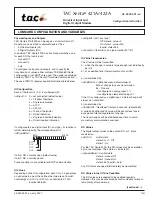
User's Guide Digiface AES
©
RME
39
21. Digital Connections
21.1 AES/EBU
The
Digiface AES’s provides one AES/EBU input and output via XLR. Connection is accom-
plished using balanced cables with XLR plugs. Input and output are transformer-balanced and
ground-free. The incoming channel status is ignored.
AES/EBU (and SPDIF) can contain Emphasis information. Audio signals with Emphasis have a
high frequency boost, requiring high frequency attenuation on playback.
An Emphasis indication gets lost as there exists no standardized interface on computers to
handle this information!
Operation as second SPDIF I/O
Thanks to a highly sensitive input stage
SPDIF coaxial can be fed too by using
a
simple cable adapter RCA/XLR. To achieve this,
pins 2 and 3 of a male XLR plug are connected
individually to the two pins of a RCA plug. The ca-
ble shielding is only connected to pin 1 of the XLR
- not to the RCA plug.
Using the cable adapter XLR/RCA described above, devices with coaxial SPDIF interface can be
connected to the AES output of the Digiface AES as well. Note that most consumer equipment
with phono (SPDIF) inputs will only accept signals having a Channel Status
Consumer
. In such
cases the above adapter cable will not work.
21.2 SPDIF (Coaxial, Optical)
The Digiface AES has up to three SPDIF inputs and outputs: coaxial, optical and AES can be
used simultaneously, with different audio signals. Note that at least two sources have to be syn-
chronous, as the unit includes only one sample rate converter.
The SPDIF coaxial input accepts SPDIF and AES/EBU, Consumer as well as Professional format.
To receive signals in AES/EBU format, an adapter
cable is required. Pins 2 and 3 of a female XLR
plug are connected individually to the two pins of
a phono plug. The cable shielding is connected to
pin 1 of the XLR and the ground contact of the
phono plug.
The optical input automatically switches to SPDIF operation when such a signal is detected. The
audio information is then shown in TotalMix on the first two ADAT channels ADAT 1/2, which are
channels 7 and 8.
SPDIF coaxial Output
Apart from the audio data itself, digital signals in SPDIF or AES/EBU format have a header con-
taining channel status information. False channel status is a common cause of malfunction. The
Digiface AES ignores the received header and creates a totally new one for the output signal. The
output SPDIF coaxial can have the Channel Status Consumer or Professional, changed in the
Settings dialog. When selecting Professional, the carrier level is also doubled for better AES/EBU
compatibility.
!
Summary of Contents for Digiface AES
Page 7: ...User s Guide Digiface AES RME 7 User s Guide Digiface AES General...
Page 13: ...User s Guide Digiface AES RME 13 5 4 Overview Menu Structure...
Page 15: ...User s Guide Digiface AES RME 15 User s Guide Digiface AES Installation and Operation Windows...
Page 29: ...User s Guide Digiface AES RME 29 User s Guide Digiface AES Installation and Operation Mac OS X...
Page 37: ...User s Guide Digiface AES RME 37 User s Guide Digiface AES Inputs and Outputs...
Page 42: ...42 User s Guide Digiface AES RME...
Page 43: ...User s Guide Digiface AES RME 43 User s Guide Digiface AES Stand Alone Operation...
Page 46: ...46 User s Guide Digiface AES RME...
Page 47: ...User s Guide Digiface AES RME 47 User s Guide Digiface AES TotalMix FX...
Page 49: ...User s Guide Digiface AES RME 49...
Page 82: ...82 User s Guide Digiface AES RME...
Page 83: ...User s Guide Digiface AES RME 83 User s Guide Digiface AES Class Compliant Mode...
Page 89: ...User s Guide Digiface AES RME 89 User s Guide Digiface AES Technical Reference...
Page 98: ...98 User s Guide Digiface AES RME 39 Diagrams 39 1 Block Diagram Digiface AES...
Page 100: ...100 User s Guide Digiface AES RME...
Page 101: ...User s Guide Digiface AES RME 101 User s Guide Digiface AES Miscellaneous...
















































